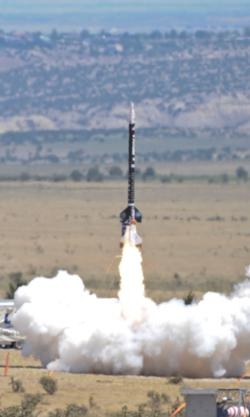College Interns From United Launch Alliance (ULA) And Ball Aerospace & Technologies Corp., K-12 Students To Launch The Largest Rocket In Colorado
More than 100 students of all ages will put their rockets and payloads on display high above the plains of Pueblo, Colorado, during the seventh annual Student Rocket Launch on Saturday, July 26.

The launch will feature three high-power sport rockets built by interns at United Launch Alliance (ULA) that will carry payloads (on-board science experiments) thousands of feet above the ground. The five largest payloads are built by Ball Aerospace & Technologies Corp. interns. K-12 students from Colorado, Ohio and Alabama created 13 additional payloads. This year's rocket team includes approximately 65 interns from ULA and 45 interns from Ball Aerospace.
The event will take place at the Hudson Ranch, located just outside of Pueblo, Colorado. Attendees are invited to view the rockets up-close on the launch pads beginning at 8:30 a.m., with the first launch at 10 a.m. The final launch will occur at noon.
This event is free and open to the public, but attendance is capped and RSVP is required. Visit the Student Launch information page on the ULA website to learn more and RSVP; ULA will send additional details about the launch, including directions to the launch site and a schedule of events, upon receiving the RSVP.
The Rockets
"The Future" (pictured above) is the largest rocket launched in Colorado, standing 25-feet tall and weighing 320 pounds. It will soar to approximately 9,000 feet above the ground, carrying 15 payloads. The "Stars 'N' Stripes" is a 20-foot rocket that will carry two payloads, and "Atlas IV," at 10 feet tall, will deploy one payload.
"United Launch Alliance is committed to encouraging science technology engineering and math (STEM) education and building the next generation of rocket scientists," said Matt Smith, ULA's vice president of Engineering and Information Technology. "The Student Rocket Launch provides one of the most in-depth, hands-on educational opportunities for interns in the country."
The Future, Stars 'N' Stripes and Atlas IV are all built and refurbished by ULA summer interns in Centennial, Colorado; Decatur, Alabama; Harlingen, Texas; Cape Canaveral Air Force Station, Florida; and Vandenberg Air Force Base, California. The interns volunteer to work on the rockets outside of their "day jobs," building and testing the rockets with the guidance of ULA employees who participate as mentors.
The Southern Colorado Rocketeers (SCORE), Colorado Springs-based rocketry club (COSROCs) and Northern Colorado Rocketry (NCR) also will be launching rockets throughout the event. This year, the event also coincides with the 56th Annual National Association of Rocketry Annual Meet (NARAM-56).
The Payloads
This year's rockets will carry a total of 18 payloads. The five largest payloads are built by Ball interns, collectively known as BIRST (Ball Intern Rocket Science Team), who design, build and test the payloads after work hours with the help of employee mentors.
This year's concepts include: a self-correcting rock-climbing car that's "driven" back by "Batman"; R/C controlled para gliders; a self-inflating balloon; a chalk cloud; and smoke grenades, environmental suites, cooling systems and many other sensors and cameras.
"Year after year exceptionally talented summer interns amaze us with their innovative approach to challenges and problem solving," said Jeff Osterkamp, Ball's vice president for Engineering. "The rocket launch aspect of the 10-week internship demonstrates their understanding of the teamwork needed to become future leaders."
Thirteen K-12 student teams from Colorado, Ohio and Alabama also designed and built payloads that will fly on the Future rocket. The payloads include a class teddy bear (named "S. Carpenter Bear" after the astronaut from Colorado), an experiment to test post-launch dispersion of bar-coded Alabama cotton bolls, and payloads designed to capture images and data using cameras, GPS, geographic information system (GIS), altimeters, accelerometers and other devices.
 ANN's Daily Aero-Linx (05.06.25)
ANN's Daily Aero-Linx (05.06.25) ANN's Daily Aero-Term (05.06.25): Ultrahigh Frequency (UHF)
ANN's Daily Aero-Term (05.06.25): Ultrahigh Frequency (UHF) ANN FAQ: Q&A 101
ANN FAQ: Q&A 101 Classic Aero-TV: Virtual Reality Painting--PPG Leverages Technology for Training
Classic Aero-TV: Virtual Reality Painting--PPG Leverages Technology for Training Airborne 05.02.25: Joby Crewed Milestone, Diamond Club, Canadian Pilot Insurance
Airborne 05.02.25: Joby Crewed Milestone, Diamond Club, Canadian Pilot Insurance



